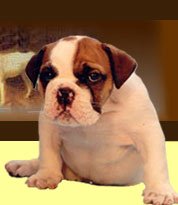BEAR AND BULL BAITING
During the reigns of Mary, Elizabeth, James I, and Charles I (1553/1649), and again during the reign of Charles II (1600/1635), bull baiting and bear-baiting was the sport of Kings, who used to regale ambassadors and other foreign personages with it. The place built in the shape of a theatre in which bulls and bears were baited, and which was mentioned by Hentzner in 1598, was the Bankside Bear Garden in Southpark, which during the reigns of Queen Elizabeth and James I was kept by Edward Alleyn, the actor and founder of Dulwich School.
As has already been shown, it was during the reign of Charles I (in 1631) that the Bulldog was first specifically mentioned by name, and the testimony of Hentzner shows that very large dogs were still used in 1598, and the probability is that exactly same type of dog was in use till the death of Charles II in 1685, because in that monarch's reign they often fought with bears and occasionally with lions at Bankside. So far as I have been able to ascertain the Alaunts of the years 1553/1630 were dogs of an average weight of at least 110 lbs., and the Bulldogs of the years 16311685 weighed on an average 90 lbs., and Mr. Frank Adcock's Toro brought over from Madrid in 1873, was probably a pretty exact counterpart of what the English Bulldog was in the years 1631/1685.
At the end of 1685 James II came to the throne, and from that day onwards bull-baiting declined as a fashionable and courtly amusement, though it continued exceedingly popular with the lower classes for another 150 years. At Bankside special kennels were erected for the great dogs that used to bait the bulls and bears. Many of whose relations had been shipped to Spain from 1556 till probably 1650 or even later. But upon the accession of James II, the Bankside Bear Garden was finally disused as a royal appurtenance, and from that time onwards the Bear Garden at Hockey-in-the-Hole, near Clerkenwell Green, was the chief venue of London devotes of the sport, another favorite place being William Well's Bear Garden and Tuttle Fields, Westminster. At these places bull and bear baiting became a very barbarous recreation shunned by the better class of people and which went furthest and fairest in against the bull, or which jumped highest against the bear, the prizes being a guinea or ten shillings or a collar.
The rules of bull baiting, as practiced from 1686 till 1835, presupposed a tethered bull or a tethered bear, and the dog was only required to ``pin" the bull, not to throw him, as was sometimes actually done in earlier years, when many of the bulls were unfettered.
THE SMALLER DOG APPEARS
The new system of bull-baiting, as practised from 1686 onwards, favoured an active dog of moderately low stature and of only moderate size, with his nose well-laid back and a protruding underjaw. The great dog of 90 lbs. in weight which had been in vogue when bull-baiting was the sport of Kings, was no longer wanted, whilst the common folk who now had the sport in hand could not afford to rear and keep such huge animals, which would have been a ``white elephant" to them. Much can happen to change any breed of dog in 50 years and by in breeding and breeding with a fixed purpose in view between the years 1686 and 1735, a dog of a definite type and of average weight of 50 lbs. was produced. The dog of 1735 was smaller in skull than the dog of the present day, longer in face, higher at the shoulder, not so wide in front, lighter in bone and body, and less exaggerated in every way, but he was the framework upon which the fin de siecle Bulldog of to-day was built up. And the dog that was gradually evolved in the years 1686/1735, though finally more than 40 per cent lighter than his ancestors of the years 1631/1686, had all the indominable pluck of his ancestors, and was not only the bravest dog but actually the bravest creature on earth, not even expecting the Old English Game Cock. This is an undisputable fact, which was proved time and time again.
The dog which was produced in the years 1686/1735, was" the dog for the bull", and it was during those years, and not before then, that he was taught and trained to pin the bull by the nose, and never to attack him in any other place. As early as 1710 this method of attack became inherited tendency, and even to-day, though bull-baiting was abolished 98 years ago, many Bulldogs still see in cattle their hereditary for, and if a young dog loses his head in a field of cattle he will nearly always try to pin the nearest beast by the nose.
By 1735, then, a fixed and definite type of Bulldog had been attained, a courageous, powerful, active dog of an average weight of 50 lbs., very different from the exhibition dog to-day, but nevertheless the groundwork upon which the exhibition dog has been gradually built up.
Source: Our Dogs, December 15, 1933.




